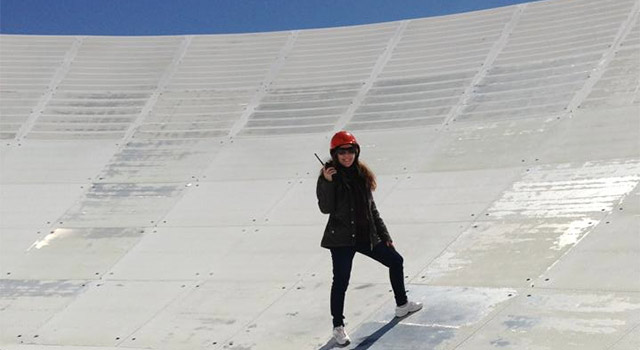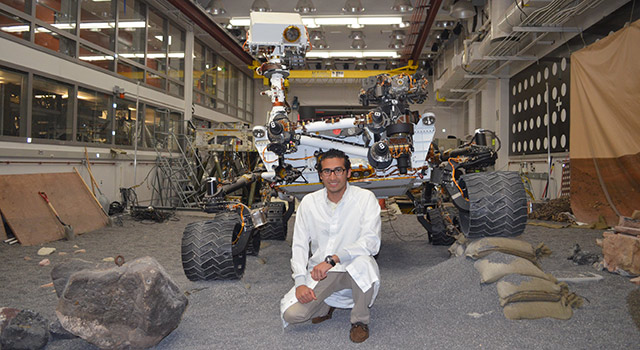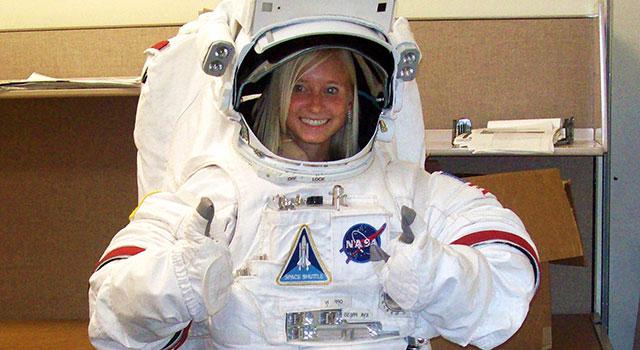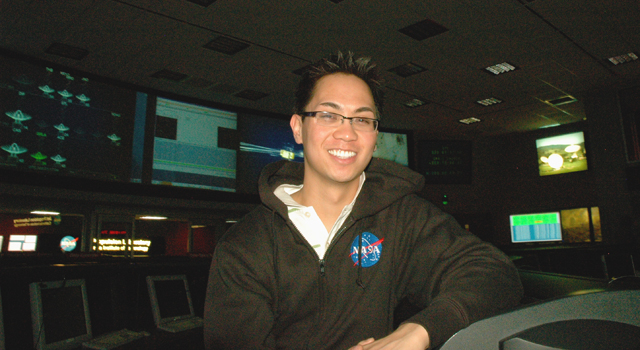Former interns share stories about how their experiences at NASA centers set them on pathways to stellar careers. Learn more about JPL internships and fellowships
Internship Pathways | April 1, 2014
A Star is Born From A Deep Space Rescue
It started as a technology test mission, but NASA's Deep Space 1 had become much more. In 1999, having already made a historic up-close encounter with asteroid 9669 Braille, the "spacecraft that could" was being pushed ever further with an extended mission to encounter two comets in a single year.
But in November of that year, something went wrong. The star tracker, a device that acts as a sort of spacecraft compass, failed, rendering the craft blind in the stellar abyss with no way of relaying its valuable reserve of science data back to Earth.
For Michela Muñoz Fernández, it was a chance to do something big.
In February 2000, Muñoz Fernández, then a master's student at France's International Space University, arrived at NASA's Jet Propulsion Laboratory in Pasadena, Calif., for the start of her three-month internship. Her task was to help analyze communications between Deep Space 1 and the ground stations that make up NASA's Deep Space Network (DSN) -- a global system of powerful antennas for spacecraft communication and navigation.
As the NASA lab that had pioneered deep space communication and managed the DSN, JPL was a mecca for aspiring telecommunications engineers like Muñoz Fernández.
"My dream was always to work on telecom, doing telecom analysis for a deep space mission," said Muñoz Fernández, who before starting her master's program had worked for the company that manages the DSN complex in her native Madrid. "So for me, it was like a dream to work on Deep Space 1."
Her dream quickly evolved into a career's worth of real-world experience when, soon after starting her internship, she was thrust into a team tasked with wrenching the science data from the wayward Deep Space 1 and potentially rescuing the mission altogether.
Working with her mentor, Jim Taylor, and the flight team, Muñoz Fernández and the group quickly devised a strategy. If mission controllers could temporarily point the spacecraft close enough toward Earth, the telecom team could send commands through the spacecraft's high-gain antenna. The strategy required that Muñoz Fernández and Taylor analyze the signals coming from the spacecraft and send commands during the small window when the antenna was pointed toward Earth. If all went according to plan, a new software package would be radioed to the spacecraft instructing it to use its onboard camera as a de facto navigation tool.
"Initially, the probability of getting the high-gain antenna pointed on Earth and keeping it there for a typical communications pass was significantly below 50 percent," said Marc Rayman, who at the time was Deep Space 1's Mission Manager. "But there were two mottos I tried to get the team to adopt: 'If it isn't impossible, it isn't worth doing,' and, 'Never give up. Never surrender.' I took the second one from the movie 'Galaxy Quest.'"
The plan worked. In 2001, Deep Space 1 made a successful flyby of comet Borrelly, snapping hundreds of up-close photos of the comet. And the operation to save the mission went down as one of the most successful robotic spacecraft rescues in history.
"I got so much done in three months. It's unbelievable what we got accomplished," said Muñoz Fernández.
Having been accepted to a doctoral program at Caltech just before the start of her JPL internship, Muñoz Fernández carried the momentum from her experience into earning her doctorate in optical communications. When she came back to JPL in 2006, she was hired as a flight and project systems engineer for the Space Interferometry Mission.
These days, she divides her time between a busy schedule of research in deep space communications, techniques for model-based systems engineering for NASA missions, and task managing information architecture standards for space systems. And she says the lessons from her internship still play an essential role in her work - as does the mentoring she received from Taylor and Kar-Ming Cheung.
"I had the best mentors, that's for sure," said Muñoz Fernández. "You work with many different people, and I realize how fortunate I was that the first time I came here, I got to work with these amazing people - not just nice people, but so knowledgeable technically."
This summer Muñoz Fernández is preparing to mentor her own students, and she says she has plenty of advice from her experience to pass along to the next generation.
"It's exciting to be able to teach new generations the knowledge that you have," she said. "And it's not only that the student learns from the mentor, but the mentor can also learn from the student. They can think of something that someone who was working here for a long time didn't think about because they come with a new perspective."
 Dr. Michela Muñoz Fernández is a principal investigator at JPL. She has also worked as a systems engineer and science payload engineer on instruments and operations for the Juno mission. She currently directs research for model-based systems engineering for NASA space missions, is a task manager for information and architecture standards, conducts research on optical communications in deep space, and studies the complexity of DSN links.
Dr. Michela Muñoz Fernández is a principal investigator at JPL. She has also worked as a systems engineer and science payload engineer on instruments and operations for the Juno mission. She currently directs research for model-based systems engineering for NASA space missions, is a task manager for information and architecture standards, conducts research on optical communications in deep space, and studies the complexity of DSN links.
TAGS: Women in STEM, Deep Space Network, Deep Space 1, Internships & Fellowships, Career Guidance, Women in STEM, Hispanic Heritage Month
Internship Pathways | March 27, 2014
Formulating the Future
There was always something about the universe that mesmerized me. I still have recollections of staring at the night sky full of stars for hours thinking to myself how somewhere in this universe, something incredibly amazing is happening and yet we might not know about it.
It wasn't until high school that I started getting involved in my
school's astronomy program and attending "star parties," where we would
spend the night looking at different celestial objects with a variety of
telescopes -- Schmidt-Cassegrains were my favorite.
A couple of years later, I found myself studying aerospace engineering at The University of Texas at Austin and learning about spacecraft design and space systems engineering. My adviser, Dr. Hans Mark, helped me apply for a summer internship at JPL during my sophomore year.
At this point, I knew little to nothing about what I really wanted to do as an aerospace engineer. I just knew I wanted to work for NASA and help scientists answer some fundamental questions about our universe, such as, "Are we alone?" or, "Is there water on Mars?"
During my first summer internship at JPL, I was part of a team of students who were tasked with designing a secondary payload for the proposed MoonRise mission. MoonRise would have been the first robotic sample-return mission from the moon. We designed a camera system that would have flown on the communications satellite and detected impact flashes from impacting meteorites.
MoonRise was not selected to fly, but this extraordinary experience completely changed my career path.
After my first summer internship at JPL, I knew exactly what I wanted to do as an aerospace engineer. I wanted to help formulate and design innovative concepts.
The next summer, I was fortunate to come back to JPL and work on the Mars Science Laboratory as a flight software team member. We were creating a platform to test the wake cycle robustness of the Curiosity rover. This once-in-a-lifetime opportunity changed me forever. Not many people can say they worked on a rover that is currently on another planet. JPL made that possible for me.
At this point, I had my mind and heart set on getting a job at JPL upon graduation, so I came back to JPL as an intern for the third time during my senior year. This time, I was tasked with working at JPL's state-of-the-art concurrent engineering facility called Team X. I had come full circle to what I was most passionate about, formulation and systems engineering.
Meanwhile, in my free time back at UT-Austin, I was designing my own mission with CubeSats -- small satellites that can fit inside a 10-centimeter cube. With the help of my other aerospace engineer friends I proposed a CubeSat constellation to detect Earth-like planets by measuring the interaction between the stellar solar wind and the magnetosphere of the exoplanets.
I graduated from UT-Austin in December of 2012 with the highest of honors and received the "2012 Cockrell School of Engineering Scholar-Leader Award" from the dean of the engineering school. None of this would have been possible without the invaluable experience I gained as an intern at JPL. The internships at JPL were real hands-on opportunities on real projects. JPL empowered me as an intern and gave me real responsibilities and tasks that everyone on the team truly cared about. My three summer internships at JPL before graduation gave me the tools and fundamentals I needed to excel in any work environment immediately after graduation.
So now I work at JPL on formulation projects as a systems engineer. I have already sponsored interns at JPL as a mentor, and I love the fact that there is no limitation to how fast you can grow here. I am currently the project systems engineer and flight systems engineer on an interplanetary CubeSat mission and work on a variety of different innovative concepts on the side.
In my free time, I go to local schools to talk to students and motivate them to pursue science, technology, engineering and math (STEM) degrees.
JPL was the tipping point in my career. Not only did I gain invaluable technical expertise from my internships, but I also gained the confidence and communication skills vital for any engineer, and especially for a systems engineer.
TAGS: Curiosity, University of Texas Austin, MoonRise, CubeSat, Systems Engineering
Internship Pathways | November 18, 2013
Lunar Lessons
When people ask me what I want to do with my life, I tell them, "Every little kid wants to be an astronaut when they grow up - but I never outgrew it." It was in eighth grade that I realized I wanted to be an astronaut and explore our solar system. The journey wasn't always easy, however. I was consistently laughed at and made fun of in high school when I would tell people that my dream was to work at NASA and one day become an astronaut. No one really expected me to stick to those dreams, let alone accomplish them.
Fast forward a few years, and I
entered college at the Florida Institute of Technology, where I
double-majored in physics and space science to learn more about stars
and comets. One moment I will never forget is orientation day for my
department. A professor asked the freshmen in the room who wanted to be
an astronaut, and every hand in the room shot up. I knew I was in the
right place.
In my sophomore year, an upperclassman sent an email around about a scholarship-internship program with NASA, called MUST (Motivating Undergraduates in Science and Technology). I figured it was a long shot, but decided to apply. To my delight, I was selected and given the opportunity to begin living out my dream by interning at Kennedy Space Center for the summer. I worked for Dr. Philip Metzger, a granular physicist who leads NASA's research into rocket blast effects for manned missions. In the Granular Mechanics and Surface Systems Laboratory, I designed and built experiments to study how the spray of lunar soil from a landing rocket will impinge upon and damage hardware at a future lunar outpost.
This NASA experience changed the course of my career, in a very good way. I suddenly realized I was far more interested in the surfaces of planets and in planetary exploration than in stars and astrophysics, and decided after that summer to pursue planetary science for my graduate studies.
I returned to KSC the next summer to work with Dr. Metzger on a new project that involved studying the compaction and magnetic properties of lunar soil using various experimental methods. We were working on developing more effective ways to store large quantities of soil for mining.
The summer before starting graduate school, I was offered an internship at JPL working on the proposed MoonRise mission, lead by my (soon-to-be) advisor, Dr. Bradley Jolliff. MoonRise would have been a robotic sample return mission to the lunar farside. I was part of a team of students who were tasked with designing an instrument to fly on the spacecraft. We designed a camera system that would have flown on the communications satellite and detected impact flashes from impacting meteorites. Unfortunately, MoonRise was not selected to fly, but the experience shaped my future career path. I realized I really enjoy the mission design and planning process and decided that summer that I wanted to both study the moon and plan for future missions.
I am now a couple years shy of having my Ph.D. in Earth and Planetary Science, and have loved the journey. My research focuses on studying the effects of rocket exhaust on lunar soil properties and volcanic complexes on the moon. Once I have finished my graduate studies, I plan to apply for a position at NASA and become involved in mission planning. I hope to work on the problems associated with rocket exhaust effects on planetary surfaces and continue to research geologically interesting locations on the moon. Ultimately, I plan to apply to become an astronaut candidate and maybe even become the first woman to walk on the moon! My NASA internships helped me realize my true passions and have paved the way for the career path I want to take. I'm incredibly happy in the field I'm in and hope that funding for both NASA and NASA education programs continues so that other students with dreams like mine have a chance to see them come true.
TAGS: Women in STEM, Planetary Science, Physics, Moon, Career Guidance, MoonRise, Women in STEM, Women at NASA
Internship Pathways | November 21, 2011
Countdown to Launch Begins for Former JPL Intern
It's five days till launch and Gregory Galgana Villar III, a mere 24 years old and a relatively new hire at NASA's Jet Propulsion Laboratory, is preparing to take part in one of the most ambitious NASA missions. In the wee morning hours of Nov. 26, Villar will step into the dark room in JPL's mission control center -- a place filled with scientists and engineers stationed at computer monitors of all kinds - to anxiously await the launch of a mission eight years in the making.
Villar is one of the youngest verification and validation engineers on NASA's Mars Science Laboratory mission team, a fact that often inspires wonder about his journey.
"I spent two years interning with three different education programs at JPL," said Villar, who participated in the Laboratory's Minority Initiatives Internship, Space Grant and Undergraduate Student Research Program as an undergrad student at Cal Poly, Pomona. "Then I started realizing I needed a job. I sent out emails to about 125 people at the lab and got a job doing cost models. After six months, opportunities with MSL came up, so I applied for a couple of positions and got one."
Tenacity has certainly worked in Villar's favor, but so has his chameleon-like ability to not only take on widely different disciplines, but also rise to success in each one. Over the years, he's gone from observing stars and planets to majoring in physics while interning at JPL with some of the most renowned scientists in the world to now working in an engineering discipline on one of NASA's flagship missions. And while his journey seems astounding to onlookers, Villar chalks it up to the basic skill of adapting.
"As with any job, it's not really your background, it's how smart you are and how well you adapt or how fast you can learn on the job," said Villar. "So long as they see that you're very motivated and smart, they'll take you on for the job."
Now part of the team that tested spacecraft operations and prepared the new Mars rover, Curiosity, for its journey to the Red Planet, Villar is making his own preparations for 7:02 a.m. PST Saturday morning when the Mars Science Laboratory launch window opens and all of the mission team's hard work pays off. It'll be just the beginning of the spacecraft's journey -- and hardly the end to Villar's. In fact, he's already set his sights on his next career move.
"I'm on the Verification and Validation team until we get to Mars," said Villar, who was also recently accepted into the astronautical engineering master's program at the University of Southern California, but is deferring until the rover has landed. "I'm working on extending my future with the mission team, but wherever JPL takes me, wherever my future takes me, is where I'll go."
TAGS: Curiosity, Launch, Internships & Fellowships, Career Guidance









